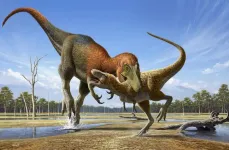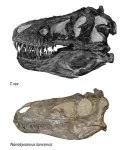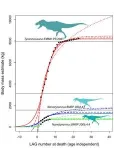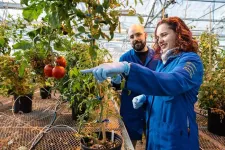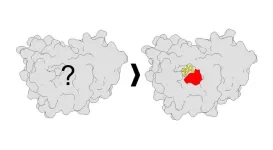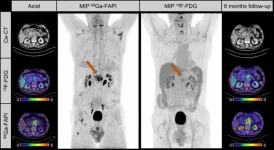(Press-News.org)
A new analysis of fossils believed to be juveniles of T. rex now shows they were adults of a small tyrannosaur, with narrower jaws, longer legs, and bigger arms than T. rex. The species, Nanotyrannus lancensis, was first named decades ago but later reinterpreted as a young T. rex.
The first skull of Nanotyrannus was found in Montana in 1942, but for decades, paleontologists have gone back and forth on whether it was a separate species, or simply a juvenile of the much larger T. rex.
Dr Nick Longrich, from the Milner Centre for Evolution at the University of Bath (UK), and Dr Evan Saitta, from the University of Chicago (USA) re-analysed the fossils, looking at growth rings, the anatomy of Nanotyrannus, and a previously unrecognized fossil of a young T. rex.
Measuring the growth rings in Nanotyrannus bones, they showed that they became more closely packed towards the outside of the bone - its growth was slowing. It suggests these animals were nearly full size; not fast-growing juveniles.
Modelling the growth of the fossils showed the animals would have reached a maximum of around 900-1500 kilograms and five metres - about 15 per cent of the size of the giant T. rex, which grew to 8,000 kilograms and nine metres or more.
The researchers have published their findings in Fossil Studies.
“When I saw these results I was pretty blown away,” said Longrich. “I didn’t expect it to be quite so conclusive.
“If they were young T. rex they should be growing like crazy, putting on hundreds of kilograms a year, but we’re not seeing that.
“We tried modeling the data in a lot of different ways and we kept getting low growth rates. This is looking like the end for the hypothesis that these animals are young T. rex.”
Supporting the existence of distinct species, the researchers found no evidence of fossils combining features of both the Nanotyrannus and T. rex - which would exist if the one turned into the other. Every fossil they examined could be confidently identified as one species or the other.
Neither did the patterns of growth in other tyrannosaurs fit with the hypothesis that these were young T. rex.
Dr Longrich said: “If you look at juveniles of other tyrannosaurs, they show many of the distinctive features of the adults. A very young Tarbosaurus - a close relative of T. rex - shows distinctive features of the adults.
“In the same way that kittens look like cats and puppies look like dogs, the juveniles of different tyrannosaurs are distinctive. And Nanotyrannus just doesn’t look anything like a T. rex.
“It could be growing in a way that’s completely unlike any other tyrannosaur, or any other dinosaur- but it’s more likely it’s just not a T. rex.”
But that raises a mystery — if Nanotyrannus isn’t a juvenile Tyrannosaurus, then why hasn’t anyone ever found a young T. rex?
“That’s always been one of the big questions. Well, it turns out we actually had found one,” said Longrich. “But the fossil was collected years ago, stuck in a box of unidentified bones in a museum drawer, and then forgotten.”
The research led Longrich and co-author Evan Saitta to a previous fossil discovery, stored in a museum in San Francisco which they identified as a juvenile Tyrannosaurus.
That young T. rex is represented by a skull bone - the frontal bone - with distinctive features that ally it with Tyrannosaurus, but which aren’t seen in Nanotyrannus. It comes from a small animal, one with a skull about 45 cm long and a body length of around 5 metres.
Dr Longrich said: “Yes, it’s just one specimen, and just one bone, but it only takes one. T. rex skull bones are very distinctive, nothing else looks like it. Young T. rex exist, they’re just incredibly rare, like juveniles of most dinosaurs.”
The researchers argue these findings are strong evidence that Nanotyrannus is a separate species, one not closely related to Tyrannosaurus. It was more lightly-built and long-limbed than its thick-set relative. It also had larger arms, unlike the famously short-armed T. rex.
“The arms are actually longer than those of T. rex. Even the biggest T. rex, has shorter arms and smaller claws than in these little Nanotyrannus. This was an animal where the arms were actually pretty formidable weapons. It’s really just a completely different animal - small, fast, agile.
“T. rex relied on size and strength, but this animal relied on speed.”
The long arms and other features suggest it was only distantly related to T. rex - and may have sat outside the family Tyrannosauridae, which T. rex is part of, in its own family of predatory dinosaurs.
The new study is the latest in a series of publications on the problem, going back decades.
Longrich said: “Nanotyrannus is highly controversial in paleontology. Not long ago, it seemed like we’d finally settled this problem, and it was a young T. rex.
“I was very skeptical about Nanotyrannus myself until about six years ago when I took a close look at the fossils and was surprised to realise we’d gotten it wrong all these years.”
The authors suggest that, given how difficult it is to tell dinosaurs apart based on their often-incomplete skeletons, we may be underestimating the diversity of dinosaurs, and other fossil species.
Longrich said: “It’s amazing to think how much we still don’t know about the most famous of all the dinosaurs. It makes you wonder what else we’ve gotten wrong.”
END
As the world moves away from gas towards electricity as a greener power source, the to-do list goes beyond cars. The vast global manufacturing network that makes everything from our batteries to our fertilizers needs to flip the switch, too.
A study from UChicago chemists found a way to use electricity to boost a type of chemical reaction often used in synthesizing new candidates for pharmaceutical drugs.
Published Jan. 2 in Nature Catalysis, the research is an advance in the field of electrochemistry and shows a path forward to designing ...
For people looking to start 2024 with a new routine to feel fitter and happier, a new study from the University of Bath suggests that combining mindfulness with exercise could be your key to success.
A study, published in the academic journal Mental Health and Physical Activity, suggests that life changes which combine both physical activity and mindfulness are most effective at lifting mood and improving health and wellbeing.
Both physical activity and mindfulness practice have well established psychological benefits. However, ...
A new artificial intelligence tool that interprets medical images with unprecedented clarity does so in a way that could allow time-strapped clinicians to dedicate their attention to critical aspects of disease diagnosis and image interpretation.
The tool, called iStar (Inferring Super-Resolution Tissue Architecture), was developed by researchers at the Perelman School of Medicine at the University of Pennsylvania, who believe they can help clinicians diagnose and better treat cancers that might otherwise go undetected. The imaging technique provides both highly detailed views of individual cells and a broader look of the ...
“[...] we discuss the implications of these novel findings on our understanding of how healthy aging affects verbal working memory processing.”
BUFFALO, NY- January 2, 2024 – A new research paper was published on the cover of Aging (listed by MEDLINE/PubMed as "Aging (Albany NY)" and "Aging-US" by Web of Science) Volume 15, Issue 24, entitled, “Age-related alterations in the oscillatory dynamics serving verbal working memory processing.”
Working memory (WM) is a foundational cognitive function involving the temporary storage of information. Unfortunately, WM ...
In the quest to understand the potential for life beyond Earth, researchers are widening their search to encompass not only biological markers, but also technological ones. While astrobiologists have long recognized the importance of oxygen for life as we know it, oxygen could also be a key to unlocking advanced technology on a planetary scale.
In a new study published in Nature Astronomy, Adam Frank, the Helen F. and Fred H. Gowen Professor of Physics and Astronomy at the University ...
Plants have to be flexible to survive environmental changes, and the adaptive methods they deploy must often be as changeable as the shifts in climate and condition to which they adapt. To cope with drought, plant roots produce a water-repellent polymer called suberin that blocks water from flowing up towards the leaves, where it would quickly evaporate. Without suberin, the resulting water loss would be like leaving the tap running.
In some plants, suberin is produced by endodermal cells that line the vessels inside the roots. But in others, like tomatoes, suberin is produced in exodermal cells that sit just below ...
After the last embers of a campfire dim, the musky smell of smoke remains. Whiffs of that distinct smokey smell may serve as a pleasant reminder of the evening prior, but in the wake of a wildfire, that smell comes with ongoing health risks.
Wildfire smoke is certainly more pervasive than a small campfire, and the remnants can linger for days, weeks and months inside homes and businesses. New research from Portland State’s Elliott Gall, associate professor in Mechanical and Materials Engineering, examined how long harmful chemicals found in wildfire smoke can persist and the ...
LA JOLLA, CA—Identifying new ways to target proteins involved in human diseases is a priority for many researchers around the world. However, discovering how to alter the function of these proteins can be difficult, especially in live cells. Now, scientists from Scripps Research have developed a new method to examine how proteins interact with drug-like small molecules in human cells—revealing critical information about how to potentially target them therapeutically.
The strategy, published in Nature Chemical Biology on January 2, 2024, uses a combination of chemistry and analytical techniques to reveal the specific places where proteins and small molecules bind ...
Respiratory syncytial virus (RSV) vaccines recently approved for people 60 and older would dramatically reduce the disease’s significant burden of illness and death in the United States if they were widely adopted like annual influenza vaccines, a new study has found.
A high level of RSV vaccination would not only potentially reduce millions of dollars in annual outpatient and hospitalization costs but would also produce an economy of scale with individual shots being delivered at a relatively modest cost of between $117 and $245 per dose, the study said.
The vaccines are currently covered by most private insurers without ...
Reston, VA—PET imaging with 68Ga-FAPI can more effectively detect and stage pancreatic cancer as compared with 18F-FDG imaging or contrast-enhanced CT, according to new research published in the December issue of The Journal of Nuclear Medicine. In a head-to-head study, 68Ga-FAPI detected more pancreatic tumors on a per-lesion, per-patient, or per-region basis and led to major and minor changes to clinical management of patients. In addition to enhancing precise detection of pancreatic cancer, 68Ga-FAPI ...
